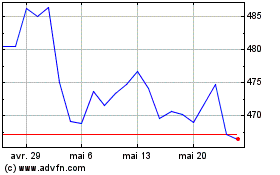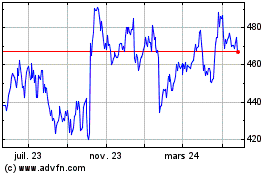U.S. Air Force Close To Declaring F-35 Jet Combat Ready
01 Août 2016 - 8:30PM
Dow Jones News
Five years behind schedule, the U.S. Air Force is this week
expected to declare that the F-35 Joint Strike Fighter jet is
finally ready for combat even as critics continue to rail against
the most expensive military program in history.
The plane's builders and military officials will likely describe
it as a milestone for a weapons program that was once hailed as the
cheapest way to replace the aging U.S. fighter fleet.
But some critics question the plane's capabilities and argue the
Pentagon is using the combat ready status of a handful of planes as
leverage to secure funding to build hundreds more jets.
The plane is designed to evade enemy radar and destroy missile
defenses and provide a flying hub to control other forces. The Air
Force is the largest customer of the jet and hopes to buy almost
1,800 costing around $100 million apiece. Hundreds more are
destined for the Navy, the Marine Corps, and international
customers ranging from the U.K. to Turkey and Australia.
Builder Lockheed Martin Corp. said it expected to generate a
fifth of its $50 billion in sales this year from the F-35. That is
expected to double by 2020 as output from the mile-long assembly
plant in Fort Worth, Tx rises to around 150 planes a year, if U.S.
lawmakers and overseas buyers agree to fund the purchases.
But it arrives late following a troubled gestation as design
problems doubled the total cost of the planned U.S. fleet to almost
$400 billion, plus another $100 billion for overseas buyers.
"The plane can fly, but there's very little it can actually do,"
said Dan Grazier at the Project on Government Oversight, a watchdog
that's been a longtime critic of the program.
The Pentagon rejects the criticism, and said combat drills have
proven the F-35 to be the most capable plane in its fleet even if
all capabilities—including a full range of weapons — won't be
available ahead of upgrades over the next several years.
The declaration of what the military calls initial operating
capability means the first squadron of F-35A model jets based at
Hill Air Force Base in Utah can now be called up to fight. The Air
Force said last week it may start using the plane in the Middle
East next year, though its full capabilities—including the ability
to fire all of the weapons used on the planes it is slated to
replace—won't be available until 2022. The U.S. Marine Corps
declared its version of the plane ready last year, though the first
jets aren't expected to be deployed in Asia until 2017.
Now-resolved design problems that included a faulty pilot helmet
and an inability to fly near lightning left suppliers such as
Northrop Grumman Corp., BAE Systems PLC and engine maker Pratt
& Whitney, a unit of United Technologies Corp., waiting to
realize their investment in higher production.
"It can't happen early enough," said David Heinz, a retired
Marine Corps general who formerly ran the F-35 program and is now
chief executive of IBC Advanced Alloys Corp, a Vancouver-based
aerospace firm that makes parts to house the jet's sensors. The
F-35 already accounts for half of IBC's $21 million annual revenue,
and the company plans to add a second production shift and hire
more staff as sales from its parts double over the next few
years.
The plane is more expensive to buy and fly than existing
aircraft, and the Pentagon and its suppliers have spent four years
on a cost-cutting drive in an effort to lower the price from well
over $100 million each to a targeted $85 million by 2019.
Lt. Gen. Chris Bogdan, the military head of the program since
2012, said reducing flying costs is even more important than the
purchase price as they account for around 70% of the estimated $1
trillion the U.S. will spend on buying and operating the planes
over their expected 50-year life. Gen. Bogdan has consulted
logistics experts at Wal-Mart Stores Inc. and other retailers in an
effort to reduce the cost of storing and supplying spare parts for
the planes around the world.
Mr. Heinz at IBC said doubts about the F-35's capabilities
extended to his own family. His son, an F/A-18 jet pilot, initially
declined to transition to the F-35 before taking part in a mock
dogfight with the new jet. Its performance changed his mind. "We're
ready to use it now," he said. "I think it will change [critics']
minds."
Write to Doug Cameron at doug.cameron@wsj.com
(END) Dow Jones Newswires
August 01, 2016 14:15 ET (18:15 GMT)
Copyright (c) 2016 Dow Jones & Company, Inc.
Northrop Grumman (NYSE:NOC)
Graphique Historique de l'Action
De Juin 2024 à Juil 2024

Northrop Grumman (NYSE:NOC)
Graphique Historique de l'Action
De Juil 2023 à Juil 2024
